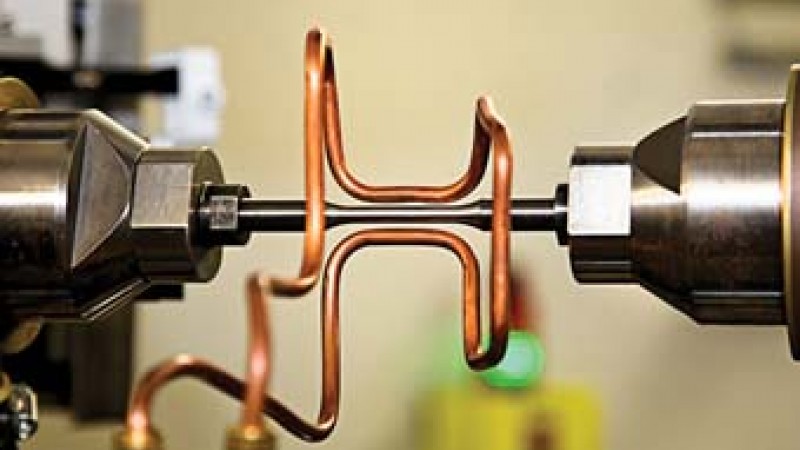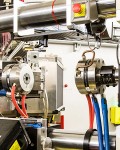Listen for any length of time to Ke An, lead scientist for the VULCAN Engineering Materials Diffractometer at the Spallation Neutron Source, and you're sure to hear about the capabilities of VULCAN that aren't available anywhere else. The instrument has become a popular tool for researchers in industry, even though it has been available to users for only a little over a year.
As its name suggests—VULCAN was the Roman god of fire and metalworking—the instrument was built with industrial applications in mind, says Xun-Li Wang, lead scientist for materials science and engineering in ORNL's Neutron Sciences Directorate. In addition to excellent neutron optics, the instrument features an open sample area that accommodates specimens ranging from a few grams of material to jet engines and vehicle bodies. The open space also enables in situ studies of materials behavior under realistic, simulated operating conditions.
The massively capable instrument is a big draw for scientists and engineers working to advance battery technology. Before VULCAN officially opened to users, a research team led by Zhili Feng of ORNL's Materials Science and Technology Division, Wang, and An used it to conduct pioneering experiments on lithium-ion batteries as part of an ongoing collaboration with industry. Since then, the ORNL team has been working with General Motors, Dow Kokam and other battery manufacturers. Besides these direct collaborations, academic researchers are using VULCAN to explore the inner lives of batteries to improve their performance.
Better batteries are essential to transitioning vehicle drive systems from internal combustion engines to electrical motors. To succeed as power sources, batteries must be quick and convenient to charge, long lasting, reliable and able to power a vehicle for a reasonable distance without recharging. Li-ion batteries are popular for the automotive market because they store a lot of energy and are relatively lightweight. But performance degradation as batteries are depleted and recharged hundreds of times is a persistent issue and a barrier to widespread adoption of electric vehicles.
To slow battery degradation, scientists and engineers need to understand atomic level mechanics of the process under working conditions. That requires looking into the battery's molecular structure and observing chemical phenomena occurring in a battery's anode and cathode as it works. "VULCAN lets us observe the structural evolution in both electrodes in real time. Its unique capabilities and the unique power of the pulsed SNS neutron beam allow us to take 'snaphots' of the process at closer time intervals and and collect more comprehensive data faster than ever before," An says.
"Seeing" Internal Changes
The initial GM experiments examined battery cells for electric vehicles after hundreds of charge/discharge cycles. (An EV battery consists of hundreds of such cells.) Neutrons were used to map several points inside the molecular framework of the cells to see how internal stresses and irregularities were distributed. The cells were then charged and mapped again on VULCAN to show structural differences between the charged and discharged state for a degraded battery. They were also probed with neutrons during a series of charge/discharge cycles, allowing the GM team to "see" structural changes inside the batteries as they occurred.
The GM team was very surprised by the power of VULCAN and satisfied with the results it obtained, says An, and soon returned to VULCAN for a second set of experiments on a new EV battery. This time, they were able to observe, in real time, lithium ions being absorbed into the carbide structure of a battery as it charged and discharged. "This was the first time data have been collected in real time at such close intervals using neutron scattering," An notes.
"We used high-intensity neutron beams to observe the real-time charge and discharge of a battery—not a slow discharge over several hours, but a real-time discharge, in real-world conditions, in less than an hour," An explained. The neutrons showed the actual chemical reactions as lithium moved from one side of the battery electrode to the other. "We now can use neutrons to see this; once we understand this process, we can tune it," he says.
Inconsistent conditions, such as charge levels, current densities, and temperatures across battery cells are suspected of accelerating degradation, but there is little quantitative information about how they do so, says Stephen Harris of the GM Technical Center, an expert in Li-ion battery research. VULCAN's ability to measure transient phenomena like these at microsecond time steps allowed the experimenters to precisely track environmental conditions in different areas of the battery cells as charging/discharging progressed.
An added advantage is that the high power of the SNS neutron beam—the most intense pulsed beam in the world—enabled the team to complete its studies in less than a week.
The team completed a third set of measurements on the GM batteries at VULCAN during early 2011 and has an experiment on a degraded battery scheduled for later in the year, says Feng. "For the coming experiment, the battery we studied before will be charged and discharged by several hundreds of cycles or more to be degraded," he says. "We'll cycle the battery to 50 to 70 percent of its original capacity and repeat the experiment we did before, looking at the structural and chemistry evolution to understand the degradation mechanism."
Reaching out to Industry
With a set of 25 instruments in the user program at SNS and the High Flux Isotope Reactor, ORNL is broadening its outreach to potential industrial users. VULCAN is one of several instruments at SNS and HFIR with a user base in industry. The Neutron Residual Stress Mapping Facility and General Purpose Small-Angle Neutron Scattering Diffractometer at HFIR regularly conduct experiments driven by industrial needs, notes Wang. HFIR staff members are working with a number of American manufacturers to improve product lines such as diesel engines, heating and cooling systems and batteries. The research at SNS and HFIR is also closely watched by research and development departments across a swath of other industries, including pharmaceuticals, electronics, solar cells, fuel cells, nuclear power, plastics, transportation, mining and petroleum, says Thomas Proffen, leader of Neutron Sciences's powder diffraction group.
ORNL is eager to show industrial users that neutron scattering can provide them with the information they need, Proffen says. Researchers from industry tend to have a different agenda than academic scientists, who explore problems at great length and value even inconclusive results, he says. Industry researchers "want to know enough to answer a question. The pressure is on them to obtain reliable results they can report back quickly."
Neutron Science's strategies for growing its industrial user base include holding workshops to show potential users what neutron research can do, making access to the facilities easier, and providing tools to help users analyze their data.
"It's a matter of finding out what problems industry is trying to address," Proffen says."Once we know that, we connect the people who know the research techniques with the people who have the problems and move on from there."
This research was funded by the U.S. Department of Energy Office of Basic Energy Sciences.






